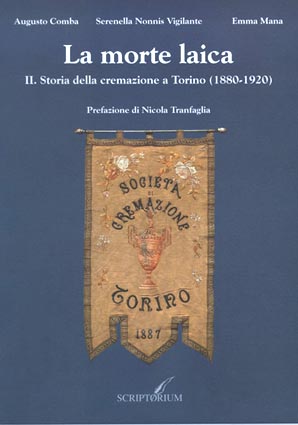Via E. De Sonnaz 13 - 10121 Torino (Italia)
Tel. 011-547005 Fax 011-547019
| HOME PAGE | ABOUT US | SCIENTIFIC COMMITTEE | HISTORY ARCHIVES | LIBRARY |
| PUBLICATION SRESEARCHES |
TRAINING | MEETINGS | SCHOLARSHIPS | LINKS |
Publications

La morte laica. Vol. II
Storia della cremazione a Torino (1880-1920), Scriptorium-Paravia,
Torino, 1998
The
Secular Death Vol.II
History of Cremation in Turin (1880-1920), Scriptorium-Paravia, Torino, 1998
SUMMARY
ASSOCIARSI OLTRE LA VITA (1882-1925)
ASSOCIATING BEYOND LIFE (1882-1925)
by Emma Mana
Capitolo primo: L'idea e la cosa nella Torino dei
primi anni Ottanta.
(Chapter 1: The idea and the ‘thing’ in Turin at the beginning of the
Eighties)
1. L'ambiente scientifico e culturale (The
cultural and scientific background)
2. L'impulso organizzativo (The
organizing drive)
3. Il Tempio (The Temple)
Capitolo secondo: La struttura societaria
(Chapter 2: The corporate structure)
1. Le
norme
2. La lettera e la prassi (Letter
and procedures)
3. I bilanci (Balances)
Capitolo terzo: Soci e cremati. Un'analisi
quantitativa e qualitativa.
(Chapter 3: Members and cremated people – A quantitative and qualitative
analysis)
1. La base di dati (Data)
2. I cremati (Cremated people)
3. I soci (Members)
4. Reti di relazione (Relation
network)
Capitolo quarto: I dirigenti
(Chapter 4: Managers)
1. All'insegna della continuità (Under
the banner of continuity)
2. Il momento della battaglia (The
time of conflict)
3. Il momento della diffusione (The
time of spread)
Capitolo quinto: Ragioni e rappresentazioni di una
scelta.
(Chapter 4: Reasons and representations of a choice)
1. I testamenti (The
wills)
2. I funerali (The
funerals)
3. Le epigrafi (The epigraphs)
I CITTADINI TRA INUMAZIONE E CREMAZIONE: LA POLITICA DEL COMUNE DI TORINO (1860-1930)
CITIZENS
BETWEEN INTERMENT AND CREMATION: THE TURIN MUNICIPALITY POLICY
by Serenella Nonnis Vigilante
Capitolo primo: L'igiene al potere
(Chapter 1: Hygiene in power)
1."La vittoria della scienza" (“Victory
of Science”)
2. Sindaci, consiglieri e funzionari pubblici (Mayors,
town councillors and officials)
3. "Dalle parole ai fatti" (“From
words to facts”)
Capitolo secondo: Il Servizio mortuario della città
(Chapter 2: The town mortuary service)
1. Il cimitero: una struttura ad "altissimo
riferimento istituzionale" (The
cemetery: a structure “strongly related to institutions”)
2. Educare al culto della tomba (Educating
to the cult of the tomb)
3. Un servizio pubblico e laico "creato dal nulla" (A
public and secular service “created out of nothing”)
Capitolo terzo: Nuovi scenari in Consiglio
comunale
(Chapter 3: New scenaries in the
Municipality Council)
1. La scomparsa di una "falange combattiva e
forte" (The
vanishing of “a strong and fighting host”)
2. Il declino della tensione ideologica (The
waning of the ideological tension)
Capitolo quarto: L'improbabile "addio alle
salde radici del passato"
(Chapter 4: An unlikely “farewell to the strong roots of the past”)
1. Un dilemma sconosciuto ai più. Il terrore della morte
apparente
(A dilemma unknown to most people: the fear of catalepsy or apparent
death)
2. Un funerale "dignitoso" (A
“dignified” funeral)
LA MASSONERIA TRA FILANTROPIA E PEDAGOGIA
FREEMASONRY
BETWEEN PHILANTHROPY AND PEDAGOGY
by Augusto Comba
Capitolo primo: Il retaggio della tradizione
(Chapter l: The legacy of tradition)
1. Una tradizione solidaristica e didattica
(A tradition of solidarity and education)
2. L'insegnamento massonico in Torino capitale (The
Freemasonry example in capital Turin)
Capitolo secondo: L'impegno cremazionista delle
logge
(Chapter 2: The cremationist commitment of the lodges)
1. Si rialzano le colonne e si parla di cremazione (Columns
are lifted again and cremation is reconsidered)
2. Si
fonda a Torino la Società per la Cremazione (The
Cremation Society is founded in Turin)
3. Si moltiplicano le iniziative filantropiche (Increasing
of philanthropic initiatives)
4. Belle époque: cambiano i maestri e i benefattori (Bélle
Epoque: new masters and benefactors)
5. Guerra
e dopoguerra: cambia il partito della borghesia (The
war and after the war: the middle classes party changes)